



















|
 |
|
 |

This page lists the Goidlic (or Irish) units, British & Gaul regionals & uniques and the most common Celtic troop types. The units listed under Celtic can be recruited from a large number of provinces, some ranging from Ireland to Galatia.
Cladaca (Goidilic Light Infantry)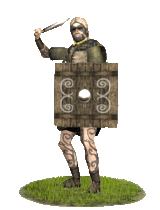 The Cladaca (Klad-ak-ah; Sword Carriers) are the backbone of the early Goidilic (Gaelic or Goedelic) warrior society. They are well trained, fairly organized, and willing to fight for their patrons always. They are equipped, firstly, with several darts thrown at very short range, with very heavy heads made so they can go through armor, shields, and helmets. They also have well made shields, and an iron sword, the Cladaca are able melee combatants, prepared to engage enemy infantry, even those of seemingly slightly superior quality. Their scaith (shield) is well taken care of, it is never taken to a fight in disrepair if there is time to fix it. Their weapons are sacred, and a warrior's respect for his weapons shows his respect for his tribe, because it is the weapons in his hands that will defend his people, and he cannot properly defend them if his weapons are rusted, dented, or broken. These warriors are made to engage most any threat at need. The Cladaca (Klad-ak-ah; Sword Carriers) are the backbone of the early Goidilic (Gaelic or Goedelic) warrior society. They are well trained, fairly organized, and willing to fight for their patrons always. They are equipped, firstly, with several darts thrown at very short range, with very heavy heads made so they can go through armor, shields, and helmets. They also have well made shields, and an iron sword, the Cladaca are able melee combatants, prepared to engage enemy infantry, even those of seemingly slightly superior quality. Their scaith (shield) is well taken care of, it is never taken to a fight in disrepair if there is time to fix it. Their weapons are sacred, and a warrior's respect for his weapons shows his respect for his tribe, because it is the weapons in his hands that will defend his people, and he cannot properly defend them if his weapons are rusted, dented, or broken. These warriors are made to engage most any threat at need.
Historically, the Goidils were not a single group of Celts, but intermingled blood of Gauls, Britons, Belgae, and even Iberians. The Cladaca were mixtures of all of the warrior traditions of these people. They were well equipped, and trained regularly, making them the most basic of professional warriors of the Goidilic people. Each man was taught to be self sufficient, with skills like cooking, hunting, and fishing, but also taught poems and songs, and orative skills, so to inspire one another. Each Cladaca was intended to be an individual warrior on the field, able to fight on his own if he was needed to. Mock duels were often a game for young Goidils, to improve their skill with their spears, axes, and swords, and with their scaith, the shield they would use to deflect enemy blows, as well as dart throwing games, to ensure they were good with their darts.
Vellinica (Goidilic Levy)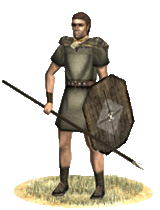 The Vellinica (Val-lin-ik-ah; Swift Fighters) are the most basic warriors of the Goidilic (Gaelic or Goedelic) tribes, and are thankfully cheap to maintain. They fight as spearmen, with good quality, reinforced spears. The Vellinica are only semi-professional. They work and train about four months a year, than rotate back to working as farmers, craftsmen, fishermen, etc., while their replacements go to train and fight. They are expensive to outfit compared to most light spearmen, but they are comparatively well trained and high spirited. The Vellinica (Val-lin-ik-ah; Swift Fighters) are the most basic warriors of the Goidilic (Gaelic or Goedelic) tribes, and are thankfully cheap to maintain. They fight as spearmen, with good quality, reinforced spears. The Vellinica are only semi-professional. They work and train about four months a year, than rotate back to working as farmers, craftsmen, fishermen, etc., while their replacements go to train and fight. They are expensive to outfit compared to most light spearmen, but they are comparatively well trained and high spirited.
Historically, the Vellinica were used well into the dark and middle ages, and the inheritors of an ancient fighting tradition. While young Goidils always played games that honed fighting skills, these semi-professionals also spent much time at work, so were not as skilled as the better trained, year-round professional Cladaca, but were not as unskilled as the all but untrained militias that were used as impromptu forces.
Cruvamendica (Goidilic Cavalry)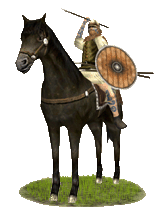 The Cruvamendica (Crowv-ah-men-dik-ah; Horse Companions) are the regular cavalry of the Goidils (Gaels or Goedelics). They ride upon sure-footed, hardy ponies, and are outfitted with heavy throwing spears and a thrusting spear. Their speed and versatility, as well as the necessity to have viable cavalry, make them invaluable on the wet, marshy ground, and the rocky hills of Hibernia. They can outpace chariots and heavier horses in such areas, and the smaller size of their mounts allows them to be hidden for ambush easily, and allows them to fight favorably compared to other cavalry in forests. The Cruvamendica (Crowv-ah-men-dik-ah; Horse Companions) are the regular cavalry of the Goidils (Gaels or Goedelics). They ride upon sure-footed, hardy ponies, and are outfitted with heavy throwing spears and a thrusting spear. Their speed and versatility, as well as the necessity to have viable cavalry, make them invaluable on the wet, marshy ground, and the rocky hills of Hibernia. They can outpace chariots and heavier horses in such areas, and the smaller size of their mounts allows them to be hidden for ambush easily, and allows them to fight favorably compared to other cavalry in forests.
Historically, the Goidilic tribes adopted ponies as mounts in favor of heavier horses and chariots, generally (some chariots and larger horses were used) because the ground of Ireland was too wet or rocky for a chariot or horse to move over swiftly. The ponies they bred could run with great speed over marsh and hills. Cavalry like this was used for swift hit-and-run attacks, as well as infantry breaking cavalry assaults at enemy flanks. These ponies had a great deal of strength and weight, allowing their actual charge to collide with great force, able to trample opponents.
Ordmalica (Goidilic Shock Infantry))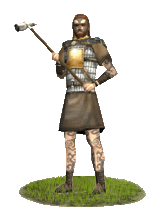 The Ordmalica (Ord-mul-ik-ah; Hammer Fighters) are a type of Goidilic (Gaelic or Goedelic) heavy infantry; they're rare, experienced, and very wealthy. The wield massive, two-handed hammers, imitating Dagda, "the good god"; they smash and crush attackers, break armor, and smash cavalry mounts. These men are small in number, but they serve a strong purpose on a battle field, though they are slow to be mustered, and small in number. However, their weapons, skill, and fair quality armor, allow them to be used as strong anti-armor infantry. Their main disadvantage is impetousness; Celtic religious fanatics are not known for their restraint in most matters, combined with the essence of a Celtic warrior's lust for glory, they are extremely impetous, and are quick to break their loose formation. The Ordmalica (Ord-mul-ik-ah; Hammer Fighters) are a type of Goidilic (Gaelic or Goedelic) heavy infantry; they're rare, experienced, and very wealthy. The wield massive, two-handed hammers, imitating Dagda, "the good god"; they smash and crush attackers, break armor, and smash cavalry mounts. These men are small in number, but they serve a strong purpose on a battle field, though they are slow to be mustered, and small in number. However, their weapons, skill, and fair quality armor, allow them to be used as strong anti-armor infantry. Their main disadvantage is impetousness; Celtic religious fanatics are not known for their restraint in most matters, combined with the essence of a Celtic warrior's lust for glory, they are extremely impetous, and are quick to break their loose formation.
Historically, the Goidils used hammers in large numbers; they were popular enough that later Irish and Scots still used them widely as the favored weapon of many field officers. The reason behind the favor given to the hammer is two-fold. It is a religious symbol. The main god of the Goidils wields a massive hammer from which he forged all creation, and with which he defends his people. It is also a practical weapon. It requires minimal craftsmenship, it's sure to kill or incapacitate its target in a single blow, and it can be used to kill cavalry, light infantry, and smash the armor of heavy infantry. They would be at a great disadvantage at range, where arrows could cut them down, as they lack a shield, and are slowed by the weight of their weapons, but in a melee, they would be quite fearsome.
Eiras (Goidilic Noble Infantry)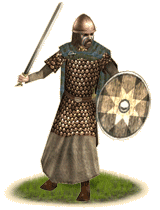 The Eiras (Ar-es; Nobles) are Goidilic chiefs and their retainers. Equipped better than other Goidilic soldiers, they're also generally far more experienced; this accounts for their position as retainers of a chief. There are literally hundreds of chiefs though, beholden to chieftans, who are beholden to lesser kings, beholden to a high king. They carry throwing spears and longer iron swords than other swordsmen would often have a chance to carry. Their experience, high morale, and strength of their attacks make them valuable, and their presence inspires others to fight. The Eiras (Ar-es; Nobles) are Goidilic chiefs and their retainers. Equipped better than other Goidilic soldiers, they're also generally far more experienced; this accounts for their position as retainers of a chief. There are literally hundreds of chiefs though, beholden to chieftans, who are beholden to lesser kings, beholden to a high king. They carry throwing spears and longer iron swords than other swordsmen would often have a chance to carry. Their experience, high morale, and strength of their attacks make them valuable, and their presence inspires others to fight.
Historically, early Ibero-Celtic Ireland was populated by numerous tribes with an overking, from which spawned the seat of the high king that fell into constant contest by the time Rome fell, and the sub-kingdoms of Ireland were rendered into warring splinters. However, despite the varying periods of relative stability with a kind of warring states period, the Goidils always relied on a tribal model, with each family being headed by an elected chief, who acted as the tribe's spokesman to the mounting tiers of officials. Such men would have private guards and champions that would also fight as heavy infantrymen. While the armaments of such soldiers may have changed over time, their general purpose would not have changed. In this period, the Goidils were rather prolific traders with most western powers, and even reportedly bought, among other things, armor from Carthage, which they would then modify slightly to fit their needs.
Dubosaverlacica (Ebherni Armoured Shock Infantry)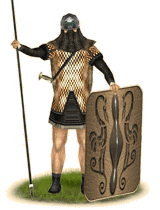 Dubosaverlacica (Doo-bos-sav-air-lak-ik-ah; Blackened Fighting Ones), are an absolute elite of all of the Goidilic tribes. They stem from only a single tribe, the influential Ebherni or Iverni (descendants of the Vasci - Iberian invaders of Hibernia). They are armored in Ceannlann (Shawn-lun), "Fish Scale". It is a layer of scales upon linen, upon chain. This multi-layer armor covers their body, and is nearly impenetrable. These nobles are so called for the black markings on their weapons. They are always of an incredibly small number, their armor is actually probably inherited, due to the great expense and difficulty in producing it. Their faces are hidden behind a chain veil, giving them a truly otherwordly appearance. Their skill at arms is insurmountable, their armor is all but impenetrable. While tiny in number, they can defeat much larger numbers, and are nearly unstoppable. They are loyal, but somewhat lethargic, difficult to rouse to battle, requiring great deals of compensation, but they are easily among the greatest warriors in the known world. However, their slim numbers ensure they must be used wisely, or else be thrown away. Dubosaverlacica (Doo-bos-sav-air-lak-ik-ah; Blackened Fighting Ones), are an absolute elite of all of the Goidilic tribes. They stem from only a single tribe, the influential Ebherni or Iverni (descendants of the Vasci - Iberian invaders of Hibernia). They are armored in Ceannlann (Shawn-lun), "Fish Scale". It is a layer of scales upon linen, upon chain. This multi-layer armor covers their body, and is nearly impenetrable. These nobles are so called for the black markings on their weapons. They are always of an incredibly small number, their armor is actually probably inherited, due to the great expense and difficulty in producing it. Their faces are hidden behind a chain veil, giving them a truly otherwordly appearance. Their skill at arms is insurmountable, their armor is all but impenetrable. While tiny in number, they can defeat much larger numbers, and are nearly unstoppable. They are loyal, but somewhat lethargic, difficult to rouse to battle, requiring great deals of compensation, but they are easily among the greatest warriors in the known world. However, their slim numbers ensure they must be used wisely, or else be thrown away.
The Dubosaverlacica in Ireland are known from few sources. One, a mostly intact suit of Ceannlann only recently discovered, and another, the Luachmharleanbhan (Lok-mor-len-bon), "Precious Children", a lengthy tract, still being translated, on the warriors employed by the ancient Goidils and Belgae. They are noted at the fields of Firbosis, engaging the Firbolg ('sackmen', actually a slur for indepedent Belgae, and not related to the earlier people Firbolg, or the mythic Firbolg). The Belgae numbered in the thousands. The king of the Goidils sent "Lugh's Blessed", the Uachtarach DuboGaiscaocha, ahead of his army, and they numbered only forty. The Dubosaverlacica had killed nearly one-third of the Belgae by the time the other Goidils reached the battle (surely an exaggerated report). This victory supposedly solidified the rule of a single Goidilic king into the early 1st century AD, over most of Ireland.
British Isles
Balroae (Caledonian Skirmishers)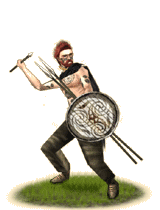 The Caledonians are a fierce people on the edge of the world. Beyond Caledonia stretches a great, empty ocean, and Caledonia itself is home to a rather isolated people. They are seemingly relics of a former era of Celtic history, they do not have great deals of iron, and so do not produce many swords. They instead fight with more practical weapons, spears, javelins, and slings. Balroae (Bal-ro-ee; "Strong Men") are a vast number of men, of many ages and varying levels of experience. Seemingly fearless, and wild, their bodies are tattooed in esoteric spiral designs, their hair is spiked and red, and they are remarkably fearsome. They are very hardy and brave; their lifestyle demands it. Alone, a disciplined army would destroy them, but if incorporated into a more tactics minded commander of the more advanced Britons, they may prove more useful. The Caledonians are a fierce people on the edge of the world. Beyond Caledonia stretches a great, empty ocean, and Caledonia itself is home to a rather isolated people. They are seemingly relics of a former era of Celtic history, they do not have great deals of iron, and so do not produce many swords. They instead fight with more practical weapons, spears, javelins, and slings. Balroae (Bal-ro-ee; "Strong Men") are a vast number of men, of many ages and varying levels of experience. Seemingly fearless, and wild, their bodies are tattooed in esoteric spiral designs, their hair is spiked and red, and they are remarkably fearsome. They are very hardy and brave; their lifestyle demands it. Alone, a disciplined army would destroy them, but if incorporated into a more tactics minded commander of the more advanced Britons, they may prove more useful.
Historically, the Caledonians were never conquered by the Romans, despite Romans successfully defeating them in numerous engagements. The small amount of iron available to them was only enough to produce swords for the most wealthy or greatest of champions. Even bronze armor was a luxury. The Caledonians did not have much cavalry, or any chariots, they only had their own fierce nature as their greatest weapon. Any chariots were likely imported from Hibernian tribes, or Britons fleeing Roman rule, and any cavalry was really just these men mounted on ponies. They were a true relic of a bygone period, still fighting without much in the way of tactics beyond ambushing and mad rushes at their enemies. These people would exist for a long time, until invading Gaels, Germans, Normans, and Norsemen would eventually conquer and assimilate them.
Argyn Marca (Caledonian Noble Cavalry)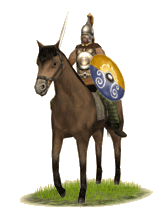 The nobility of Caledonia are not so wealthy or well-equipped as their neighbors to the south, not to say that they are less well-off as the Celts of the continent. However, the Argyn Marca (Arg-en Mar-kah; "Noble Horse") are a far cry from the lower ranking levies that make up most of a Caledonian army. Mounted on ponies, armored in scale and helmets, and equipped with the best of local goods, they are the heaviest cavalry in Britain, and this gives them a serious advantage over the cavalry light Britons. Their charge is powerful, and their ponies are manueverable. Even against superior cavalry, their ability in forests can be used to great advantage. Their charge is augmented by an effective hail of javelins.
The nobility of Caledonia are not so wealthy or well-equipped as their neighbors to the south, not to say that they are less well-off as the Celts of the continent. However, the Argyn Marca (Arg-en Mar-kah; "Noble Horse") are a far cry from the lower ranking levies that make up most of a Caledonian army. Mounted on ponies, armored in scale and helmets, and equipped with the best of local goods, they are the heaviest cavalry in Britain, and this gives them a serious advantage over the cavalry light Britons. Their charge is powerful, and their ponies are manueverable. Even against superior cavalry, their ability in forests can be used to great advantage. Their charge is augmented by an effective hail of javelins.
Historically, Caledonians hadn't many horses, resulting in most of their cavalry being composed of nobles and their retinues. Their horsemen were experienced fighting in the dense forests of northern Britain and in Ireland, and they were experienced at leading raids. Caledonians were not as disciplined as most of the enemies they faced, but they did have considerable ferocity and individual skill; augmented by their nobles, they could defeat seemingly superior enemies.
Imannae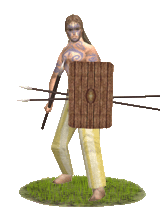 The Imannae (Im-an-ay; Ambushers) are youths used throughout many less developed Celtic territories to ambush and disorient enemies. In an army, they generally act as a screen before the main force, loosening the enemy formations before the older warriors charge. They are actually more akin to a militia arm, and are employed by tribes in dire need of defense; they are best employed as hit-and-run soldiers. If left into a melee, they will break and flee. The Imannae (Im-an-ay; Ambushers) are youths used throughout many less developed Celtic territories to ambush and disorient enemies. In an army, they generally act as a screen before the main force, loosening the enemy formations before the older warriors charge. They are actually more akin to a militia arm, and are employed by tribes in dire need of defense; they are best employed as hit-and-run soldiers. If left into a melee, they will break and flee.
Historically, the Celts had to rely heavily on skirmishers when their armies were weakened. However, they also used them to weaken campaigning and marching foes, and as a light warband for raids, as well as screen their armies. They were very prolific ambushers; most Celtic territory was wooded with many places to launch such attacks from, and these types of soldiers would be of most use in similar terrains. As young men still trying to raise their status, it is unlikely they were very sturdy in a prolonged battle. It was not unusual for such 'warriors' to take up jobs as mercenaries, to ensure better pay than they could normally get for their station, and some probably even went into outright banditry.
Silurae Birnai (Siluri Warband)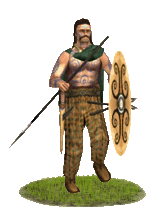 The Silurae Birnai (Sel-oor-ay Bern-ay; Silurii Warband) are a tribe from the south of Cambria. Reknowned for their ferocity, skill, and discipline, they offer up fine spearmen to their lord, braver than most others, and more sturdy and skilled. They are, for all intensive purposes, little more than local spearmen, but of greater trainer and skill. The Silures fill the same role, acting as both anti-infantry and anti-cavalry soldiers, and can also be used to pepper an enemy at distance with javelins. They are disciplined and capable of standing in orderly lines and use tight formations at times to absorb enemy charges. The Silurae Birnai (Sel-oor-ay Bern-ay; Silurii Warband) are a tribe from the south of Cambria. Reknowned for their ferocity, skill, and discipline, they offer up fine spearmen to their lord, braver than most others, and more sturdy and skilled. They are, for all intensive purposes, little more than local spearmen, but of greater trainer and skill. The Silures fill the same role, acting as both anti-infantry and anti-cavalry soldiers, and can also be used to pepper an enemy at distance with javelins. They are disciplined and capable of standing in orderly lines and use tight formations at times to absorb enemy charges.
Historically, the Silures were a bit of an anomaly; they were a somewhat dark-skinned tribe living in the south of what is now Wales, surrounded by much paler Celts. It was postulated by some Romans that they had even been from Iberia originally, accounting for their tone and hair. Irregardless, the Silures were apparently quite loyal. When the high king of the Britons, Caratacus, fled into Cambria to escape the Romans, he was recieved and supported by the Silures, who, though likely they were his vassals, probably had little to actually gain by continuing to support him. The Silures were given their due for bravery though, and ultimately the Romans recruited aide of several opposing tribes to finally successfully subdue them.
Drwdae (Druids)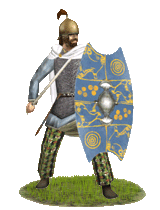 The Drwdae (Droo-day; Druids) are not actually generally warriors. However, there were British warrior-druids; war was a fine profession, and even the best educated of society sometimes engaged in it. These particular Drwdae are warriors, however, and akin in many ways to the Carnutes of Gaul, in that they train a great deal and have the duty of protecting sacred places. They are extremely well motivated and disturbing to enemies, and inspiring to allies, but exist in such small number they're no use alone; they must be supported by other men to fight at their utmost. The Drwdae (Droo-day; Druids) are not actually generally warriors. However, there were British warrior-druids; war was a fine profession, and even the best educated of society sometimes engaged in it. These particular Drwdae are warriors, however, and akin in many ways to the Carnutes of Gaul, in that they train a great deal and have the duty of protecting sacred places. They are extremely well motivated and disturbing to enemies, and inspiring to allies, but exist in such small number they're no use alone; they must be supported by other men to fight at their utmost.
Historically, British druids main duty was philosophical, legal, and religious. Warriors of this class did apparently exist though, in small numbers, acting as what were essentially temple guards, and organizers of defense. While the druids are most notable in late Celtic-British history as having been slaughtered by the Romans at Mona, graves and legends of Celtic history do attest to the druids engaging in combat. In fact, so frightening could they be, conflicts were sometimes averted when the druids took the field in support of one tribe over another; an alliance with the druids meant an invariably great amount of power in Britain.
Calawre (Casse Champions)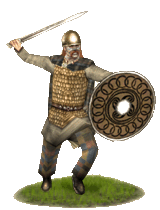 Celts are a collection of hero cultures, and the Britons are no different. Among their southern tribes especially, there are warriors of exceedingly great skill, who use Gallic equipment. The Calawre (Call-a-oo-re; "Champions") are not actually generally real champions, but they wealthy, and skilled. They have good armor and good Gallic swords. They are called champions more because of their appearance than anything; they actually mostly simply fill in the need for more affordable, all-purpose heavy infantry among the Britons. They are skilled, and professional, but their expense generally would keep their numbers low. Celts are a collection of hero cultures, and the Britons are no different. Among their southern tribes especially, there are warriors of exceedingly great skill, who use Gallic equipment. The Calawre (Call-a-oo-re; "Champions") are not actually generally real champions, but they wealthy, and skilled. They have good armor and good Gallic swords. They are called champions more because of their appearance than anything; they actually mostly simply fill in the need for more affordable, all-purpose heavy infantry among the Britons. They are skilled, and professional, but their expense generally would keep their numbers low.
Historically, the Britons had little in the way of 'real' heavy infantry. Most often they relied on wealthy champions to fill that need. However, sometimes they did employ bands of wealthier warriors, who were not necessarily the greatest skilled, but they would be easier to mass in one place than a group of real champions, and, while they wouldn't be AS skilled, they certainly had to have a talent for combat to survive as long as they had to afford their equipment, which was likely imported. However, the Britons also were fond of using leather and bronze scale, which was made locally. These shirts would be lined under with padding, so they could be worn comfortably. Such armor grew far more popular in wake of Roman invasion, due to armor worn by some auxilia being of similar design.
Kluddargos (Briton Sword Masters)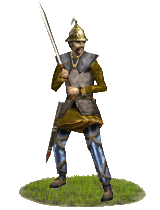 Kluddargos (Klud-arr-gus; "Sword Masters") are British champions who they employ very specialized weapons. Their weapons, longswords gripped in two hands instead of one, with especially heavy blades made to crush armor, require years of practice to master. Able to afford such weapons, they can also afford high quality armor; very fine quality chain shirts. Like other heroes and champions, they are marched to battle to inspire their fellow tribesmen, but their special weapons also give them a tactical purpose; annihilate enemy armor. Their great swings split helmets, smash shields, and collapse cuirasses into the body. These weapons are truly fierce and destructive. The heads they collect will surely be from grotesquely mangled bodies, obliterated by the force of their blows, and the wielders of such weapons likely took an amount of grim satisfaction to find their foes' bodies left in such a state. Kluddargos (Klud-arr-gus; "Sword Masters") are British champions who they employ very specialized weapons. Their weapons, longswords gripped in two hands instead of one, with especially heavy blades made to crush armor, require years of practice to master. Able to afford such weapons, they can also afford high quality armor; very fine quality chain shirts. Like other heroes and champions, they are marched to battle to inspire their fellow tribesmen, but their special weapons also give them a tactical purpose; annihilate enemy armor. Their great swings split helmets, smash shields, and collapse cuirasses into the body. These weapons are truly fierce and destructive. The heads they collect will surely be from grotesquely mangled bodies, obliterated by the force of their blows, and the wielders of such weapons likely took an amount of grim satisfaction to find their foes' bodies left in such a state.
Historically, two-handed longswordsmen were rare but fearsome champions, generally open only to the most wealthy of southern 'Gallic' British tribes who could afford to import the chain, and craft longswords. However, these longswords were made specially with more weight in the final portion of the blade to ensure it would have the ability to crack into armor. They were likely introduced originally as a method of killing other champions, or enemy chieftains, who would be well armored. However, their weapons possibly could be employed akin to the Goidilic and continental equivalents, as wide swinging weapons intended to cut down multiple, lighter armored targets at once, but such wide swings would be awkward due to the weight of the furthest portion of the weapon. Two-handed longswords were not unusual altogether for Celtic peoples, though rare outside of a few regions, particularly the eastern Celtic kingdoms and tribes, such as Lugians, and among the Goidils, but they would likely also be found with Gauls, Belgae, and other Celtic cultures as the weapon of choice for some champions or ceremonial pieces.
Batacorii
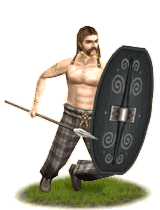 Batacorii are the file warriors of the Belgae, a group of extremely fierce tribes that were highly independent, well trained and experienced in war. Shunning the 'comforts' often afforded the members of the 'civilised' states, they pride themselves on their rugged way of life, their toughness of mind and body and their skill at arms. Batacorii are the file warriors of the Belgae, a group of extremely fierce tribes that were highly independent, well trained and experienced in war. Shunning the 'comforts' often afforded the members of the 'civilised' states, they pride themselves on their rugged way of life, their toughness of mind and body and their skill at arms.
The Belgae Batacorii utilize well-made spears and a few decent javelins. Extremely fit and experienced in warfare, they make good melee warriors and impromptu skirmishers. Their versatility, and eagerness for battle / low relative expense, mean they are a fine warrior band for enterprising warlords looking to expand their lands. While unarmoured, they have good quality shields and are well trained in using them to fend of attack.
Milnaht
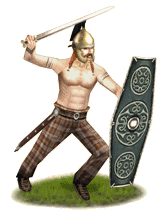 The Milnaht (Mel-not; "Great Men") are a very fierce group of warriors. With lands in the north of Gaul, south of Britain, and middle of Hibernia, the Belgae have spread themselves over a fairly wide area. They are a fair mix of Britons and Gauls, with portions of the more civilized Gallic culture mixed into the more tribal and fierce culture of the Britons. They still wear bronze helmets and sometimes employ bronze weapons as back ups. However, they use a great deal of iron in swords, spear, javelin and arrow heads, and chain shirts worn by their nobles. The professional warriors of the Belgae are bare chested warriors with a long, bronze rimmed shield, and bronze helmet, and sometimes painted with the elaborate designs popular to the Britons. Their ferocity and skill with their swords and shields make them capable of standing against slightly heavier warriors. They are also capable of sapping, and have a penchant for undermining walls, making them valuable to any army of Britons marching into Europe, where they are bound to encounter stone fortifications. If the Gauls or a tribe of Britons ever managed to incorporate Belgae regions into their lands, they would undoubtedly try and use them in battle. Aside from their charge, they form an impressive, tight 'shieldwall' type of formation, to resist opposing charges. The Milnaht (Mel-not; "Great Men") are a very fierce group of warriors. With lands in the north of Gaul, south of Britain, and middle of Hibernia, the Belgae have spread themselves over a fairly wide area. They are a fair mix of Britons and Gauls, with portions of the more civilized Gallic culture mixed into the more tribal and fierce culture of the Britons. They still wear bronze helmets and sometimes employ bronze weapons as back ups. However, they use a great deal of iron in swords, spear, javelin and arrow heads, and chain shirts worn by their nobles. The professional warriors of the Belgae are bare chested warriors with a long, bronze rimmed shield, and bronze helmet, and sometimes painted with the elaborate designs popular to the Britons. Their ferocity and skill with their swords and shields make them capable of standing against slightly heavier warriors. They are also capable of sapping, and have a penchant for undermining walls, making them valuable to any army of Britons marching into Europe, where they are bound to encounter stone fortifications. If the Gauls or a tribe of Britons ever managed to incorporate Belgae regions into their lands, they would undoubtedly try and use them in battle. Aside from their charge, they form an impressive, tight 'shieldwall' type of formation, to resist opposing charges.
Historically, the Belgae were a number of extremely fierce tribes that were highly indepedent. However, they were fairly well trained, their violent behavior toward most outsiders forced them to learn tactics and the finer points of warfare to defend themselves from their many, many enemies. The lower warriors would fight bare chested almost always, even in winter, though they actually wore cloaks to the point of the battle, then would toss them aside to fight. Among the Belgic tribes were the Nervii, easily among the most fierce of all the Celtic peoples, and many of the first Celtic invaders into Ireland. The Belgae fought using three main manners, their fierce forward charge, their skilled and methodic ambushes, and their hit-and-run skirmish tactics. They were also skilled sappers and tacticians, but above all remembered is the charge and shieldwall. The Belgae could break near any enemy with a fierce charge, and if they could not, their good skill with their weapons and shields allowed them the power to stand and fight, and their wall could absorb most infantry charges with ease.
Taramannos
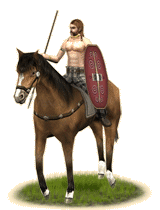 The Taramonnos (Tar-ay-mon-os; "Thunderers") were the light cavalry of the Belgae. Devoted to the thunder god, Tarannis, they were said to replicate the sound of thunder in their attacks; a somewhat disturbing trait at least. They are lighter than the horsemen of the Gauls, but fight in a similar manner. They throw javelins and use charge and retreat tactics to weaken and eventually break an enemy, in concert with infantry charges, and harrying tactics to weaken marching foes. Depicted on their shields are symbols of their chosen patron, Tarannis, the symbol of thunder and lightning. The Taramonnos (Tar-ay-mon-os; "Thunderers") were the light cavalry of the Belgae. Devoted to the thunder god, Tarannis, they were said to replicate the sound of thunder in their attacks; a somewhat disturbing trait at least. They are lighter than the horsemen of the Gauls, but fight in a similar manner. They throw javelins and use charge and retreat tactics to weaken and eventually break an enemy, in concert with infantry charges, and harrying tactics to weaken marching foes. Depicted on their shields are symbols of their chosen patron, Tarannis, the symbol of thunder and lightning.
Historically, the Belgae were a number of extremely fierce tribes that were highly indepedent. However, they were fairly well trained, their violent behavior toward most outsiders forced them to learn tactics and the finer points of warfare to defend themselves from their many, many enemies. The lower warriors would fight bare chested almost always, even in winter, though they actually wore cloaks to the point of the battle, then would toss them aside to fight. Among the Belgic tribes were the Nervii, easily among the most fierce of all the Celtic peoples, and many of the first Celtic invaders into Ireland. The Belgae fought using three main manners, their fierce forward charge, their skilled and methodic ambushes, and their hit-and-run skirmish tactics. They were also skilled sappers and tacticians, but above all remembered is the charge and shieldwall. The Belgae could break near any enemy with a fierce charge, and if they could not, their good skill with their weapons and shields allowed them the power to stand and fight, and their wall could absorb most infantry charges with ease.
Remi Mairepos
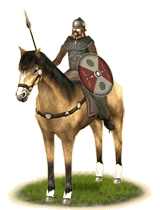 The Remi were famed horsemen. Brave, unrelenting, and powerful, their cavalry could ride over opposition, and rout numerically superior enemies; their Mairepos (Mar-ep-os; "Great Horses") were able to smash infantry and their armor, shields, and weapons were of good quality, and their skill was unquestionable. They were superior to other Gallic heavy cavalry, but they hailed only from one tribe, and like any cavalry would be vulnerable to longspears and pikes. All the same, properly employed, they could turn a losing situation into a victory. The Remi were famed horsemen. Brave, unrelenting, and powerful, their cavalry could ride over opposition, and rout numerically superior enemies; their Mairepos (Mar-ep-os; "Great Horses") were able to smash infantry and their armor, shields, and weapons were of good quality, and their skill was unquestionable. They were superior to other Gallic heavy cavalry, but they hailed only from one tribe, and like any cavalry would be vulnerable to longspears and pikes. All the same, properly employed, they could turn a losing situation into a victory.
Historically, the Remi were a feared Belgae tribe. Their cavalry was of great skill compared to that of the Gauls, and they made good account of themselves in all battles where they were present, regardless of the outcome. They acted bravely, and performed many actions that would have been suicidal if not for their training and skill, and probably also their fearsome reputation that would weaken the resolve of their foes.
Gaelaiche (Celtic Spearmen)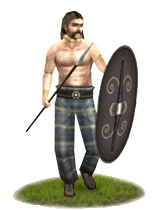 Celtic warbands have always largely relied on spears. The Gaelaiche (Guy-latch; "Spear-Warriors") are the lightest members of the Celtic warrior class. They carry cheap equipment; Celtic longspears, javelins, and a shield. However, they have their uses. Their spears are good against horsemen, and can be used to good affect against infantry as well, and their javelins can be used as a fine method to disorient a foe. Experienced spearmen are a great asset to a campaigning Celtic army, and even inexperienced spearmen are generally superior to any early levies that can be produced. The many transalpine Gallic tribes arm themselves in this manner, but also a handful of tribes in southwest Britain also use such armaments and fighting style. Celtic warbands have always largely relied on spears. The Gaelaiche (Guy-latch; "Spear-Warriors") are the lightest members of the Celtic warrior class. They carry cheap equipment; Celtic longspears, javelins, and a shield. However, they have their uses. Their spears are good against horsemen, and can be used to good affect against infantry as well, and their javelins can be used as a fine method to disorient a foe. Experienced spearmen are a great asset to a campaigning Celtic army, and even inexperienced spearmen are generally superior to any early levies that can be produced. The many transalpine Gallic tribes arm themselves in this manner, but also a handful of tribes in southwest Britain also use such armaments and fighting style.
Historically, Celts always favored spears; they were easy to produce and didn't require much steel. Celtic longspears were of fair quality, with broad, sharp heads that would cause deep, terrible gashes, and could be used as well to bring down horses. They would accompany these weapons with javelins thrown into an enemy position to disorient and kill a few foes. They would probably be mostly the youngest Celtlic warriors, but there wasn't shame in an older, experienced warrior fighting with a spear as well; the spear was a respected weapon in Celtic society.
Bagaudas (Celtic Shortswordsmen)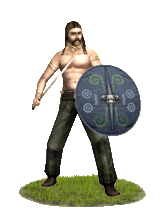 Bagaudas ("Guerilla Fighters") are shortswordsmen from the tribe of the Venetii. The shortsword is a common weapon, essentially a very long knife or dagger, and used by hunters, and carried by many as a form of self defense. Warriors using shortswords are not generally very well trained, if at all. However, they are readily available, cheap, and have a good charge. They are extremely vulnerable at range. Bagaudas ("Guerilla Fighters") are shortswordsmen from the tribe of the Venetii. The shortsword is a common weapon, essentially a very long knife or dagger, and used by hunters, and carried by many as a form of self defense. Warriors using shortswords are not generally very well trained, if at all. However, they are readily available, cheap, and have a good charge. They are extremely vulnerable at range.
Historically, the Celts generally favored spears and shortswords for young or inexperienced soldiers. These warriors, with shortswords, were not necessarily that high up in society; the swords were of debatable quality. Many may not even have fought in battle before, just being hunters or young boys called in to fight, or have chosen to go and fight. Light swordsmen in Celtic society were fairly common, and necessary, often, as a bridge between light and medium infantry, when medium infantry was unavailable. They were increasingly more common during the Roman conquests, as the professional armies with longswordsmen had either been bought by the Romans, or turned on one another, leaving the only defense to these young warriors.
Brihentin (Gallic Noble Cavalry)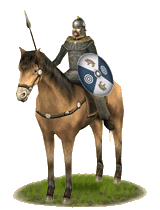 Gallic Brihentin (Bree-hen-ten; Knights) are heavy cavalry. They are used as shock cavalry to break an enemy position and destroy flanks, as well as overrun heavy infantry and slaughter lighter cavalry. Their spears, swords, and chain armor is all of finest quality, and their skill is great, though they are, as any cavalry, vulnerable to long spears and pikes. They can be used to best effect for riding down enemy heavy infantry and defeating light cavalry. Their armor can absorb many blows, and that should allow them to keep fighting. Gallic Brihentin (Bree-hen-ten; Knights) are heavy cavalry. They are used as shock cavalry to break an enemy position and destroy flanks, as well as overrun heavy infantry and slaughter lighter cavalry. Their spears, swords, and chain armor is all of finest quality, and their skill is great, though they are, as any cavalry, vulnerable to long spears and pikes. They can be used to best effect for riding down enemy heavy infantry and defeating light cavalry. Their armor can absorb many blows, and that should allow them to keep fighting.
Historically, the Gauls employed heavy cavalry as a method of breaking dense enemy formations, and were sometimes employed by Carthage, in addtion to various Gallic chiefs and kings. They were apparently of great enough skill to impress their employers; Hannibal grouped his Gallic heavy cavalry with his Iberian heavy cavalry during his campaign in the Italic peninsula. Such warriors would cost much to outfit, but they would surely be worth everything spent to ensure they had the best possible equipment.
Solduros (Gallic Noble Infantry)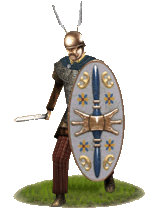 The Solduros (Sul-dur-ohs; "Devoted Ones") are remarkably skilled, fearless elite guards of Celtic nobles. They pledge themselves to eachother and their charge, and fight to the very end. Small in number, they are a remarkable elite, best used to combat an enemy's opposing elite soldiers or heavy troops. They are very well armored and armed, and can surely break many enemies, but they are rare, very expensive, and while their armor and shields are of good quality, they have no form of retaliation at range, and would be too slow to chase off skirmishers or missile troops, and so would need ranged or cavalry support to be used to best effect. The Solduros (Sul-dur-ohs; "Devoted Ones") are remarkably skilled, fearless elite guards of Celtic nobles. They pledge themselves to eachother and their charge, and fight to the very end. Small in number, they are a remarkable elite, best used to combat an enemy's opposing elite soldiers or heavy troops. They are very well armored and armed, and can surely break many enemies, but they are rare, very expensive, and while their armor and shields are of good quality, they have no form of retaliation at range, and would be too slow to chase off skirmishers or missile troops, and so would need ranged or cavalry support to be used to best effect.
Historically, Celtic nobles surrounded themselves with elite bodyguards of kings, magistrates, and other important nobles and officials, such as high ranking druids. Among them were the "Soldurii", the greatest warriors of the Aquitanni. Each man pledged his life to a fellow of this brotherhood, and the man pledged to would return this pledge; if the one of these two died, and the other did not, the remaining man would take his own life after the battle, for having failed defend him. Julius Caesar noted that no man ever backed down from this duty, and did so fearlessly. Their skill was tremendous; they fought against great odds and could defeat many times their own number. So great and legendary was their name even to their enemies that it can be found having influenced words such as 'soldier' and 'solidarity'.
Massaliotai Hoplitai (Massilian Medium Hoplites)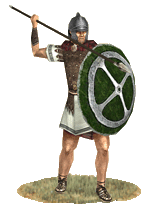 Massalia is a city in an interesting position. It is a Greek city, but with a substantial Celtic population and relations with neighboring Celtic tribes. Its soldiers have adjusted themselves with some Celtic gear to make them of greater use in a close melee if the phalanx is abandonned. They make use of a superior Celtic longsword in close quarters, able to handle themselves better in such situations compared to others with lesser weapons. Massalia is a city in an interesting position. It is a Greek city, but with a substantial Celtic population and relations with neighboring Celtic tribes. Its soldiers have adjusted themselves with some Celtic gear to make them of greater use in a close melee if the phalanx is abandonned. They make use of a superior Celtic longsword in close quarters, able to handle themselves better in such situations compared to others with lesser weapons.
Historically, Massalia was home to a substantial Greco-Celt population who were attracted to the temple of Herakles there. The inhabitants of Massalia remained largely Greek in culture, but trading, intermarrying, and fighting with nearby Celtic tribes led to crossovers in the equipment carried by each side. The soldiers of Massalia, for example, began using Celtic-style longswords and occassionally other pieces of equipment. They fought, otherwise, in a manner more typical of Hellenic soldiers.
Iaosatae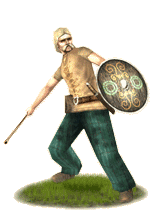 Iaosatae (Yo-sah-tie; "Slingmen") are a varied lot, some young and some old, who've been educated in the art of sling combat. They're quite skilled with their slings, which are truly a deceptively simple weapon. A sling bullet, when slung by a skilled man, will bury itself inside of its target, or break bones. Either way, the one hit is incapacitated or dead. Impressive for what amounts to a leather strip and a rock. The sling is also inexpensive, and with an impressive range. This allows Iaosatae to be both effective and affordable. However, when the distance between them and the enemy is closed, their low expense is quickly made up for in the ease of their breaking and fleeing, as, armed with only light weapons, they are not intended to fight hand-to-hand.
Iaosatae (Yo-sah-tie; "Slingmen") are a varied lot, some young and some old, who've been educated in the art of sling combat. They're quite skilled with their slings, which are truly a deceptively simple weapon. A sling bullet, when slung by a skilled man, will bury itself inside of its target, or break bones. Either way, the one hit is incapacitated or dead. Impressive for what amounts to a leather strip and a rock. The sling is also inexpensive, and with an impressive range. This allows Iaosatae to be both effective and affordable. However, when the distance between them and the enemy is closed, their low expense is quickly made up for in the ease of their breaking and fleeing, as, armed with only light weapons, they are not intended to fight hand-to-hand.
Historically, the Iaosatae would have been a variety of warriors, mostly young men though with little experience in close combat. Few older men continued to use the sling, it would generally be replaced by a spear or sword, but it never fell out of favor with younger men, who could use it for war, games, and hunting. However, their youthfulness, and lack of experience with the grimmer face of combat, makes them prone to run, because, after all, a man fifty meters away with a sword looks a lot different two meters away. Making matters worse for them, their inexperience in close combat means they probably aren't as hardy as other warriors, with more experience fighting in long engagements. Slings were popular with levy warriors in all of Celtic culture, as it didn't take long to train one in the basics, and skilled slingers who went on to become somewhat elite professionals were often well-versed in both sling and short spear combat, meaning an experienced group of Iaosatae would double as impromptu light infantry.
Sotaroas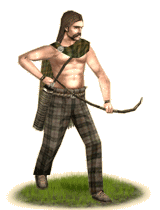 Celtic archers, Sotaroas (Sow-tah-rows, "Bow Soldiers"), while not great or exceptional, are good. They are well trained, disciplined, and can put a fair deal of range behind their attacks. While their arrows aren't too notable, their ability to swiftly pepper an enemy with arrows is always of use. They are not really meant to defeat an enemy force, or even truly damage one, so much as they are meant to irritate and draw attention away from a main force, so it can position itself for flanking. As such, they are good runners, who fire a few volleys as a distraction, and then withdraw to a safe position to hide. If caught in a melee, they would be slaughtered for sure.
Celtic archers, Sotaroas (Sow-tah-rows, "Bow Soldiers"), while not great or exceptional, are good. They are well trained, disciplined, and can put a fair deal of range behind their attacks. While their arrows aren't too notable, their ability to swiftly pepper an enemy with arrows is always of use. They are not really meant to defeat an enemy force, or even truly damage one, so much as they are meant to irritate and draw attention away from a main force, so it can position itself for flanking. As such, they are good runners, who fire a few volleys as a distraction, and then withdraw to a safe position to hide. If caught in a melee, they would be slaughtered for sure.
Historically, archers in Celtic culture had little variety, with only a few truly notable types of archers. They were irritative forces, and intended to soften large enemy forces, but rarely meant to be truly effective in the manner of eastern archers. However, if positioned properly, or experienced enough, they could be truly devastating. Their skill was good, they could fire many volleys swiftly. The Celtic concept of archery was more often to simply blacken the sky with arrows, than it was to fire few, effective volleys. However, their arrows were well made, though not great, and would be capable of puncturing lighter armors, and were quite deadly in their own right. All the same, these men were better off as hunters than field warriors.
Lugoae (Celtic Levy Spearmen)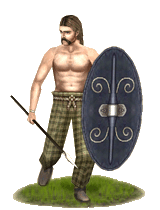 During periods of strife and war, it is necessary sometimes to call upon ordinary citizens to organize as militia. Militia in Celtic societies, called Lugoae (Lug-oo-ay; "Levy Troops"), are farmers, craftsmen, fishermen, and so on, called to brief military service in periods of crisis. They may train a few times a year to fight, and games and sports encourage a decent level of physicality, but they're still only militia, and can only be trusted to do so much. During periods of strife and war, it is necessary sometimes to call upon ordinary citizens to organize as militia. Militia in Celtic societies, called Lugoae (Lug-oo-ay; "Levy Troops"), are farmers, craftsmen, fishermen, and so on, called to brief military service in periods of crisis. They may train a few times a year to fight, and games and sports encourage a decent level of physicality, but they're still only militia, and can only be trusted to do so much.
Historically, the Celts, being a warrior culture, encouraged their people to engage in sports and games that would increase their physical strength and preparedness for war. This doesn't mean everyone was a warrior though. Those not in the warrior class would be levied into warbands at times, or form their own militias in their towns to defend themselves from outsiders and act as a type of early police force. Their weapons and equipment would be whatever they could afford personally, usually simple hunting implements, such as a hunter's spear, and a shield.
Bataroas (Northern Gallic Swordsmen)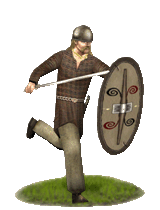 The Bataroas hail from a region the Romans call Transalpine Gaul (Gaul the other side of the Alps). Raised from the Celtic Warrior Class, these Gauls are proud and experienced fighters who often value feats of impetuous valour over acts of more prudent common sense. The Bataroas hail from a region the Romans call Transalpine Gaul (Gaul the other side of the Alps). Raised from the Celtic Warrior Class, these Gauls are proud and experienced fighters who often value feats of impetuous valour over acts of more prudent common sense.
Despite a Celtic propensity to become easily discouraged when faced with determined opposition and to suffer under a hot sun, an unwary foe will soon be parted with their head. The Celts are large men and the Bataroas use their strength to hurl their spears at great distances before closing with their long swords.
Botroas (Southern Gallic Swordsmen)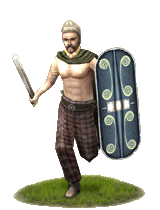 The Botroas (Boat-rows, "Sword Soldiers") are the basic medium infantry of southern Briton and Cisalpine Gaul. They are well trained, with a fair amount of experience, and good quality swords, with javelins to soften an enemy before a charge. Like near all Celtic warriors, they are loyal to a tribal head, who is himself loyal to numerous mounting tiers of nobles, leading to the king. These form the core of the southern armies. Like most Celtic shock infantry, the brunt of their attack is in the charge. The Botroas (Boat-rows, "Sword Soldiers") are the basic medium infantry of southern Briton and Cisalpine Gaul. They are well trained, with a fair amount of experience, and good quality swords, with javelins to soften an enemy before a charge. Like near all Celtic warriors, they are loyal to a tribal head, who is himself loyal to numerous mounting tiers of nobles, leading to the king. These form the core of the southern armies. Like most Celtic shock infantry, the brunt of their attack is in the charge.
Historically, the Botroas were the younger professional warriors of southern Briton and Cisalpine Gallic tribes. Their lack of armor would leave them vulnerable, but they had great mobility, and their youthfulness included a desire to prove themselves to their people, making them somewhat lacking in fear, or, perhaps, simply more afraid of disgrace than they are of death. The southern Briton warriors looked a great deal like the Cisalpine Gallic swordsmen, and fought in much the same manner.
Gaeroas (Celtic Spearmen)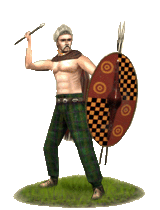 Gaeroas (Guy-rows; "Spear Soldiers") are the file warriors of the tribes of Gaul and Britain. The Gaeroas all utilize well-made long spears, and a few decent javelins, making them both fair melee warriors and impromptu skirmishers. Their versatility, and low relative expense, mean they are a fine warrior band for enterprising warlords looking to expand their lands. They have some experience with combat, but are not yet hardened to battle. However, they are trained well enough to march in a good formation, something actually lost on greater warriors for the Britons. Their longspears may seem a bit unwieldy, but this is likely to help them in combating cavalry and chariot horses as a unit. While unarmored, they have large oval shields, which provides them a good amount of protection. They are fairly well trained with these shields, and they provide a fair amount of protection from ranged attacks, but the lack of armor makes them quite vulnerable to flanking. Gaeroas (Guy-rows; "Spear Soldiers") are the file warriors of the tribes of Gaul and Britain. The Gaeroas all utilize well-made long spears, and a few decent javelins, making them both fair melee warriors and impromptu skirmishers. Their versatility, and low relative expense, mean they are a fine warrior band for enterprising warlords looking to expand their lands. They have some experience with combat, but are not yet hardened to battle. However, they are trained well enough to march in a good formation, something actually lost on greater warriors for the Britons. Their longspears may seem a bit unwieldy, but this is likely to help them in combating cavalry and chariot horses as a unit. While unarmored, they have large oval shields, which provides them a good amount of protection. They are fairly well trained with these shields, and they provide a fair amount of protection from ranged attacks, but the lack of armor makes them quite vulnerable to flanking.
Historically, spearmen in Britain and Gaul would have been the young to middle-age warriors, who had not risen greatly in prestige, or who had chosen to continue to fight as a lower warrior. They would use well-made, but not truly exceptional spears, and javelins for skirmishing. This allowed their most basic warriors to perform two duties, and allocate other soldiers to more specialized positions. Their equipment would be self maintained, and they would be expected to keep their weapons and shield in good condition. They likely paid for their own equipment, but spears and javelins are relatively cheap, the most expensive part of their equipment was likely the shield. These warriors represent the most basic professional warriors of almost all of the aforementioned tribes. They would be highly viable for the warchief who couldn't afford to bring in many swords or other weapons for his tribe.
Uirodusios (Celtic Naked Spearmen)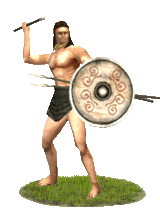 The Uirodusios (Oo-row-doo-see-os; 'Man-Demons') fight in the ancient Celtic style, stripped nude but for his torc, anklets, and bangles, and sometimes a cloak. Though poorly defended, and not nearly as skilled as the Gaesatae mercenaries of Gaul, nor on drugs, they are still formidable and present a frightening visage that unnerves enemies. These are not so much an elite as they are often only somewhat experienced warriors who wish to increase their fame by daring acts of bravery. The Uirodusios (Oo-row-doo-see-os; 'Man-Demons') fight in the ancient Celtic style, stripped nude but for his torc, anklets, and bangles, and sometimes a cloak. Though poorly defended, and not nearly as skilled as the Gaesatae mercenaries of Gaul, nor on drugs, they are still formidable and present a frightening visage that unnerves enemies. These are not so much an elite as they are often only somewhat experienced warriors who wish to increase their fame by daring acts of bravery.
Historically, some Celtic warriors fought stripped nude. This had a few effects; it was unnerving to enemies, inspiring to friends, and also helped increase one's fame; an important matter in Celtic warrior society. The skill of such men would vary depending, logically, on how long they'd been fighting in such a way, but it would likely offer superior mobility compared to alternative methods of combat, allowing them to manuever more swiftly in a melee. Such warriors would stand out in the front of a line to encourage other soldiers and to be the first to engage the enemy.
Cidainh (Celtic Chariots)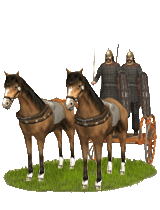 Celtic Cidainh (Kid-unk; Chariots) are an ancient vehicle of war. While soon to fall out of use in Gaul, the Cidainh are very popular in the southern tribes of the Britons, who mingle often with the Belgae, who introduced this type of chariot. The Cidainh is driven into battle, with a warrior riding on the back, who pelts the enemy with javelins. A Cidainh provides rider and driver some modest amount of protection, but the impact they can have in a battle makes them an important target for enemy forces. The mobility of the Cidainh is a bit limited, they have a wide turning radius, making them less mobile than cavalry, but their role as highly mobile skirmishers, with a well armored rider who can focus purely on the enemy, and not having to drive, leaves them with some good practical use. Celtic Cidainh (Kid-unk; Chariots) are an ancient vehicle of war. While soon to fall out of use in Gaul, the Cidainh are very popular in the southern tribes of the Britons, who mingle often with the Belgae, who introduced this type of chariot. The Cidainh is driven into battle, with a warrior riding on the back, who pelts the enemy with javelins. A Cidainh provides rider and driver some modest amount of protection, but the impact they can have in a battle makes them an important target for enemy forces. The mobility of the Cidainh is a bit limited, they have a wide turning radius, making them less mobile than cavalry, but their role as highly mobile skirmishers, with a well armored rider who can focus purely on the enemy, and not having to drive, leaves them with some good practical use.
Historically, chariots in Gaul were falling out of favor, replaced steadily by more mobile cavalry. However, they would still be used at least as late as 230 BC. In Britain, however, the Britons did not face many enemies that would force them to reconsider the role of chariots in then modern warfare. Instead, they would refine the chariots, and continue to employ them for a very long time. The chariots of the southern Britons were almost identical to those of Gaul, as they were both heavily influenced by La Tene culture, which inspired the bronze fixtures and hubs. These were generally more stable chariots than the more northern, Halstatt-style chariots. Traditionally, a Celtic chariot was driven to a battle, and the warrior could pelt the enemy at a distance, then dismount the chariot and engage the opposition on foot, without the slightest amount of exhaustion. If the battle went awry, the chariot would return, the warrior would remount, and ride away from the fight.
Golberi Curoas (Northern Gallic Mercenary Swordsmen)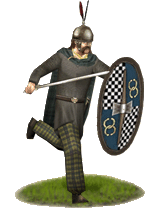 The La Tene Celts were used as mercenaries all over Europe and Africa by the Romans, Carthaginians, other Celts, and various peoples. These men often form the core of a mercenary army, and are usually tough veterans who have seen many different campaigns and have taken pay from many different masters. They are an excellent heavy infantry, well able to deal with most opponents. They are armed with javelins and spears and use these javelins to break up an enemy formation before the charge. As with most Celts, the charge can become disorderly, but it often succeeds in breaking through the enemy line none-the-less. Their name, Curoas (Koo-roo-as) means "Paid Soldiers". The La Tene Celts were used as mercenaries all over Europe and Africa by the Romans, Carthaginians, other Celts, and various peoples. These men often form the core of a mercenary army, and are usually tough veterans who have seen many different campaigns and have taken pay from many different masters. They are an excellent heavy infantry, well able to deal with most opponents. They are armed with javelins and spears and use these javelins to break up an enemy formation before the charge. As with most Celts, the charge can become disorderly, but it often succeeds in breaking through the enemy line none-the-less. Their name, Curoas (Koo-roo-as) means "Paid Soldiers".
Historically, Celtic mercenaries were used all over the ancient world. Graves and artifacts have been found even into Asia. Celts were rightly famed for their ferocity in battle, as well as a number of innovations in arms and armor development. There were many Celts willing to leave their tribes and serve other masters in exchange for wealth. This made them somewhat untrustworthy, willing to flee if a battle went poorly, as they didn't fight for honor or glory, but money, and money was useless if one was dead. The La Tene Celts actually encompassed a number of sub-cultures, most notably Gaul, but also the Lugians, Belgae, most Britons, and others. This meant that in much of Europe, Celtic warriors were never far away, and so, for the wealthy general, he could have always had at least some heavy infantry on hand.
Enoci Curoas (Southern Gallic Mercenary Swordsmen)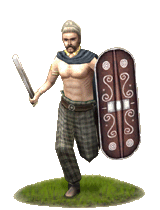 The La Tene Celts were used as mercenaries all over Europe and Africa by the Romans, Carthaginians, other Celts, and various peoples. These men often form the core of a mercenary army, and are usually tough veterans who have seen many different campaigns and have taken pay from many different masters. They are an excellent heavy infantry, well able to deal with most opponents. They are armed with javelins and spears and use these javelins to break up an enemy formation before the charge. As with most Celts, the charge can become disorderly, but it often succeeds in breaking through the enemy line none-the-less. Their name, Curoas (koo-roo-as) means "Paid Soldiers". The La Tene Celts were used as mercenaries all over Europe and Africa by the Romans, Carthaginians, other Celts, and various peoples. These men often form the core of a mercenary army, and are usually tough veterans who have seen many different campaigns and have taken pay from many different masters. They are an excellent heavy infantry, well able to deal with most opponents. They are armed with javelins and spears and use these javelins to break up an enemy formation before the charge. As with most Celts, the charge can become disorderly, but it often succeeds in breaking through the enemy line none-the-less. Their name, Curoas (koo-roo-as) means "Paid Soldiers".
Historically, Celtic mercenaries were used all over the ancient world. Graves and artifacts have been found even into Asia. Celts were rightly famed for their ferocity in battle, as well as a number of innovations in arms and armor development. There were many Celts willing to leave their tribes and serve other masters in exchange for wealth. This made them somewhat untrustworthy, willing to flee if a battle went poorly, as they didn't fight for honor or glory, but money, and money was useless if one was dead. The La Tene Celts actually encompassed a number of sub-cultures, most notably Gaul, but also the Lugians, Belgae, most Britons, and others. This meant that in much of Europe, Celtic warriors were never far away, and so, for the wealthy general, he could have always had at least some heavy infantry on hand.
Gaesatae (Gallic "Naked Fanatic" Infantry)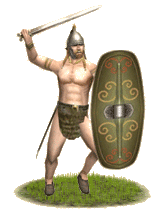 The Gaesatae (Guy-sah-tay; "Spearmen") are easily one of the most fearsome groups of warriors in the known world. They fight stripped bare but for neck torcs and sometimes their shoes or boots. They fight with longswords, but are named for their incredible skill with javelins; they can hurl them unnaturally long distances and deal great damage with them. Their charge is most ferocious though, causing many lines to simply fold and flee. This is not all solely due to skill and strength, though they are experienced and huge, muscular men. They imbibe a chemical before battle making them seemingly impervious to pain. They will fight to the very end, and are very destructive when employed properly. The Gaesatae (Guy-sah-tay; "Spearmen") are easily one of the most fearsome groups of warriors in the known world. They fight stripped bare but for neck torcs and sometimes their shoes or boots. They fight with longswords, but are named for their incredible skill with javelins; they can hurl them unnaturally long distances and deal great damage with them. Their charge is most ferocious though, causing many lines to simply fold and flee. This is not all solely due to skill and strength, though they are experienced and huge, muscular men. They imbibe a chemical before battle making them seemingly impervious to pain. They will fight to the very end, and are very destructive when employed properly.
Historically, the Gaesatae were Gallic naked religious fanatics. Their skill was a source of terror, and their frightful appearance shook many. Most horrifying, even beyond their size and skill and terrifying cries, was their seeming invincibility. A chemical they used allowed them to brush off and ignore any pain. They were remarked to do things such as rip javelins that had struck them free from their bodies, and hurl them back, and continue to fight with gashes and wounds that would have surely fell a normal man. They were Hannibal's favored Gallic mercenaries, and were used as his personal guards, as they were so devoted and trustworthy, as well as brave and skilled.
Teceitos (Celtic Axemen)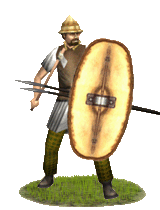 The Teceitos (Tek-ee-tos; Axe Soldiers) are a facet of a Celtic army that is not written about as much as their swords and spears, but many Celtic warriors were buried with axes, particularly in Britain and eastern Europe. The axe is a fine weapon, able to do great damage, even through armor. One can actually strike a man in a mail shirt, not damage the mail itself, but kill the wearer by the sheer amount of blunt trauma dealt to the foe's internal organs. As such, armor stands little chance against these men. They wear leather or padded vests and bronze or iron helmets to help protect themselves. They are light enough to move swiftly over the battlefield, allowing them to flank heavy infantry, and strike them from the sides or flanks. Coupled with their axes and javelins, they are especially valuable at breaking up heavy infantry; they make a great asset to chariots particularly, following the chariots into breaches in the enemy heavy infantry, and cutting open the gaps wider. The Teceitos (Tek-ee-tos; Axe Soldiers) are a facet of a Celtic army that is not written about as much as their swords and spears, but many Celtic warriors were buried with axes, particularly in Britain and eastern Europe. The axe is a fine weapon, able to do great damage, even through armor. One can actually strike a man in a mail shirt, not damage the mail itself, but kill the wearer by the sheer amount of blunt trauma dealt to the foe's internal organs. As such, armor stands little chance against these men. They wear leather or padded vests and bronze or iron helmets to help protect themselves. They are light enough to move swiftly over the battlefield, allowing them to flank heavy infantry, and strike them from the sides or flanks. Coupled with their axes and javelins, they are especially valuable at breaking up heavy infantry; they make a great asset to chariots particularly, following the chariots into breaches in the enemy heavy infantry, and cutting open the gaps wider.
Historically, Celts were, by the late La Tene, mostly recorded using spears and swords. However, in some regions, Britain and Ireland particularly, the axe was still used, and has been found in numerous burials and hordes, and axes are depicted on Caesar's coins of weapons and armor of defeated Gauls. This should not come as a surprise. The axe is easy to make, cost effective, and can be used to defeat armor or shieldwalls. The Celtic axe is not necessarily the largest of axes, but Celtic metalwork is skilled, so their heads are most likely of good quality, and upkeep would be easy for a Celtic warrior, by himself or with attendants. The head would surely keep a good edge, and even without one, a blunt edged axe can still be used to savagely hack a foe apart without the fear of it breaking like a blunted sword.
Misthophoroi Keltohellenikoi Hoplitai (Mercenary Celto-Hellenic Infantry)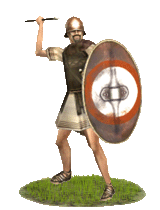 These shock infantry are Celto-Hellenic 'men-at-arms', Celtic warriors of a mixed culture. Celts have long held an affinity for Hellenic society, or at least, certain aspects of it. These men have held more than a slight one though. While they are not of especially great station, they are sufficient warriors, fighting in the Celtic manner, in a motley combination of Hellenic and Celtic gear and dress; long Celtic shields, a Greek helmet, and a Celtic spear and javelins. They soften up an opponent with their javelins and charge an enemy once they're weakened with the great brunt and force of Celtic warriors. These shock infantry are Celto-Hellenic 'men-at-arms', Celtic warriors of a mixed culture. Celts have long held an affinity for Hellenic society, or at least, certain aspects of it. These men have held more than a slight one though. While they are not of especially great station, they are sufficient warriors, fighting in the Celtic manner, in a motley combination of Hellenic and Celtic gear and dress; long Celtic shields, a Greek helmet, and a Celtic spear and javelins. They soften up an opponent with their javelins and charge an enemy once they're weakened with the great brunt and force of Celtic warriors.
Historically, Celts were at times genuinely fond of the Greeks and their society, though not often so much as to adopt their culture wholesale. However, some did adopt more than others, such as the Celtic graves around Massila and in Galatia with Celtic warriors buried in Greek clothes, with a mixture of Hellenic and Celtic objects, and evidence of Greek-speaking Celts existing in such areas. They would fight for themselves, other Celts, and, in the true mercenary nature of many Celts and Greeks alike, for those who could afford to reward them properly.
|
 |
|
 |






















|